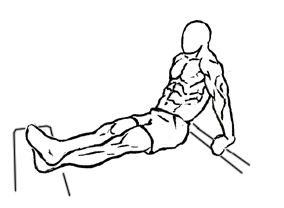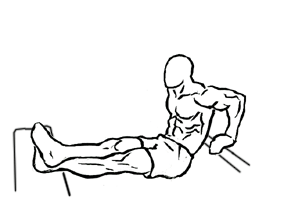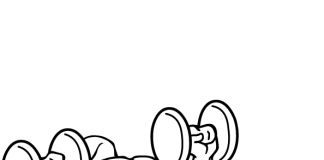Last Updated on September 30, 2022
When it comes to effective workouts, simplicity often reigns supreme. One exercise that exemplifies this principle is the bench dips. Despite its straightforward nature, bench dips are one of the most effective movements for targeting the triceps—the muscles located at the back of your arms. Whether you’re a fitness beginner or an experienced gym-goer, incorporating bench dips into your routine can significantly enhance your upper body strength. In this guide, we’ll break down the steps to perform bench dips correctly, highlight their benefits, and offer some tips to help you maximize your results.
Understanding the Triceps
Before diving into the nitty-gritty of bench dips, let’s take a moment to understand the muscle group you’ll be working. The triceps, or triceps brachii, consist of three heads: the long head, the lateral head, and the medial head. These muscles play a crucial role in elbow extension, making them essential for various pushing movements, such as push-ups and overhead presses. Strengthening your triceps not only enhances your overall upper body strength but also improves your performance in other exercises.
Benefits of Bench Dips
Bench dips offer a multitude of benefits that make them a staple in any strength training routine:
- Isolation of the Triceps: This exercise primarily targets the triceps, helping you build muscle mass and definition in the upper arms.
- Core Engagement: While the focus is on the triceps, bench dips also engage your core muscles for stability, making them a compound movement that works multiple muscle groups.
- Versatility: Bench dips can be performed anywhere there are two sturdy benches, making them a convenient option for home workouts or gym sessions.
- Adjustable Intensity: You can easily modify the intensity of bench dips by adjusting the distance between the benches or adding weight. This makes it suitable for beginners and advanced lifters alike.
- Functional Strength: Developing strong triceps through bench dips can improve your performance in everyday activities and other exercises, contributing to better overall functional strength.
How to Perform Bench Dips: Step-by-Step Guide
Now that you understand the benefits, let’s break down the steps for performing bench dips correctly. Follow these instructions carefully to ensure you’re executing the movement safely and effectively.
Step 1: Set Up Your Benches
Begin by placing two benches parallel to each other, about 3 to 4 feet apart. If you don’t have benches available, sturdy chairs or low tables can work as alternatives. The important thing is that they’re stable and can support your body weight.
Step 2: Position Yourself
Sit on one of the benches, ensuring your back is straight and your shoulders are relaxed. Extend your legs out in front of you and place your heels on the edge of the second bench, letting your legs hang freely between the two benches. For added stability, cross your feet at the ankles.
Step 3: Grip the Bench
Reach behind you and grip the edge of the bench with your hands. Your palms should face down, and your fingers should wrap around the edge for support. Your hands should be shoulder-width apart, allowing for proper alignment during the movement.
Step 4: Lower Your Body
Engage your core and slowly lower your body toward the floor by bending your elbows. Aim to keep your elbows close to your body as you lower down. Avoid flaring them out, as this can put unnecessary strain on your shoulders. Lower yourself until your elbows form a 90-degree angle.
Step 5: Pause and Return
Once you reach the 90-degree angle, pause for a moment. Then, press through your palms and extend your elbows to return to the starting position. Make sure to keep your movements controlled throughout the exercise.
Important Note on Form
While performing bench dips, it’s crucial to avoid going below a 90-degree angle with your elbows. Going lower can place excessive strain on your shoulder joints, potentially leading to injury. Always prioritize form over depth to ensure a safe and effective workout.
Variations and Progressions
Once you’re comfortable with standard bench dips, consider trying some variations to keep your workouts fresh and challenging:
1. Weighted Bench Dips
For an added challenge, you can place a weight plate or a heavy backpack on your lap during the exercise. This additional resistance will further engage your triceps and help you build strength faster.
2. Single-Leg Bench Dips
To increase the intensity and engage your core more, try performing the exercise with one leg lifted off the ground. This variation will require more balance and stability, making it a great progression as you get stronger.
3. Bench Dip with Leg Extension
Incorporate a leg extension while performing the dip. As you lower your body, extend one leg straight out in front of you. Alternate legs with each rep. This variation targets the triceps while also engaging your hip flexors and quads.
4. Dips with Feet Elevated
For a more advanced option, elevate your feet on a third bench or platform while performing the dips. This variation increases the angle of the exercise, placing more emphasis on your triceps and making it more challenging.
Common Mistakes to Avoid
While bench dips are a straightforward exercise, some common mistakes can hinder your progress or lead to injury. Keep an eye out for these pitfalls:
- Flaring Elbows: Avoid letting your elbows flare out as you lower your body. Keep them close to your sides to protect your shoulders.
- Incomplete Range of Motion: Don’t shortchange your dips by not lowering yourself enough. Ensure you reach the 90-degree angle for optimal muscle engagement.
- Sagging Hips: Maintain a straight line from your head to your heels. Avoid letting your hips sag or rise excessively, as this can compromise your form.
- Rushing the Movement: Take your time with each rep. Control is key to maximizing your strength gains and minimizing the risk of injury.
Integrating Bench Dips into Your Workout Routine
To reap the full benefits of bench dips, consider integrating them into your workout routine effectively. Here are a few ways to do so:
1. Warm-Up
Include a few sets of bench dips as part of your warm-up to activate your triceps and prepare your muscles for the workout ahead. Start with bodyweight dips to get the blood flowing.
2. Superset with Other Exercises
Supersetting bench dips with other upper body exercises like push-ups or dumbbell presses can help you build strength and endurance more efficiently. This approach keeps your heart rate up and maximizes your time in the gym.
3. Add to a Triceps-Focused Workout
If you’re targeting your triceps specifically, include bench dips in a triceps-focused workout along with other exercises like tricep kickbacks, skull crushers, and close-grip bench presses.
4. Finish with a Burnout Set
At the end of your workout, finish strong with a burnout set of bench dips. Perform as many reps as you can with good form to fully fatigue your triceps.
Bench dips are a classic yet highly effective exercise for building triceps strength and improving your overall upper body fitness. With their simple setup and versatile nature, they can easily fit into any workout routine. By following the steps outlined in this guide and avoiding common mistakes, you’ll be well on your way to mastering bench dips and achieving your fitness goals.
Whether you’re looking to tone your arms, enhance your athletic performance, or simply improve your strength for daily activities, bench dips are an excellent addition to your training regimen. So grab a couple of benches and get ready to dip your way to stronger triceps!.








